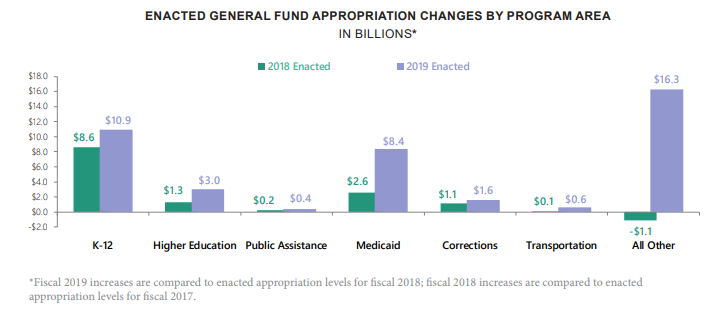It’s Been a Good Year for K-12 Budgets: 38 States Have Boosted Spending
The vast majority of states are spending more on K-12 education this academic year, as a strong economy and rising tax revenues give governors and lawmakers more breathing room than they had during the dire years of the Great Recession.
A new report released by the National Association of State Budget Officers finds that total state general fund spending for fiscal 2019–which in most states began in July and covers the ongoing school year–rose by 4.3 percent over fiscal 2018.
Those spending increases have been made possible in part by an expected 2.1 percent rise in total state tax revenue, to $868.4 billion, fueled by gains in income, corporate, sales, and other taxes, the association’s report says. While those numbers don’t match last year’s striking leap in state revenues — when they jumped 6.4 percent — it’s clear a new pool of money is brightening the conditions for state spending.
For education, that’s a good thing. Overall, 38 states have budgeted increases in spending on K-12 education in fiscal 2019, and just five have put in place cuts. (See table 9 of page 15 in the association’s report for details.)
The association also breaks out the overall size of recent K-12 state spending increases, compared with other parts of the budget. In fiscal 2019, states increased overall K-12 spending by $10.9 billion over the previous year; in fiscal 2018, it rose by just $8.6 billion. The size of spending hikes were smaller in higher education: Budgets in that area rose by $3 billion in fiscal 2019 and $1.3 billion the previous year.
For context: states spent an estimated $294.8 billion on K-12 in their general funds in fiscal 2018, the association says.
The biggest leap in overall state spending occurred in the “all other” funds category, which includes things like states’ pension fund obligations, debt service, and contributions to their reserve funds. In fiscal 2018, state spending in those areas declined by $1.1 billion, but soared by $16.3 billion in fiscal 2019.
The rising costs of pension and health care have long been a worry of state budget analysts who say it will eat into states’ ability to spend on other priorities. See the full breakdown below:

Forty-four states overall enacted increases in general-fund spending in fiscal 2019, the report says, and 16 states approved hikes greater than 5 percent.
“This reflects a considerably improved fiscal situation for states compared to this time last year,” the authors say.
Increases in spending at the state level don’t always translate into K-12 districts having a lot of new money available to them.
In fact, many district officials have told EdWeek Market Brief over the past year that while the flow of state money looks good on paper, their spending options have been limited by a host of factors, including rising local costs; limits on their ability to raise money through local taxes; the continuing pain caused by past state budget cuts; and state mandates on how to spend new money.
The pessimism at the local level came across in a spring 2018 survey by EdWeek Market Brief, which found that just 22 percent of district administrators said they expect their budgets to increase over the next two years.
K-12 spending represents one of the biggest overall chunks of total state spending, at 19.6 percent, the report points out.
Medicaid spending consumes 29.7 percent; higher education, 10.1 percent; transportation, 8 percent; corrections, 3.1 percent, public assistance, 1.3 percent, and all other expenditures, 28.3 percent.
See also:
- State Budgets for K-12 Improving, But Opportunities for Companies May Be Limited
- K-12 District Leaders Are Bearish on Budgets
